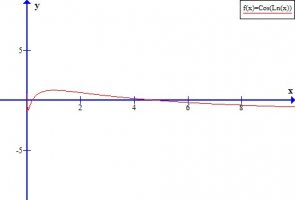You are using an out of date browser. It may not display this or other websites correctly.
You should upgrade or use an alternative browser.
You should upgrade or use an alternative browser.
Periodic functions confusiom
- Thread starter Loki123
- Start date
Dr.Peterson
Elite Member
- Joined
- Nov 12, 2017
- Messages
- 16,113
If you just want to check your answer, go to desmos.com and graph all four functions, and see which look periodic.
If you want to do only what you can do by hand, then replace x with x+T and see whether you can manipulate f(x+T) to equal f(x), for some value(s) of T.
If you want to do only what you can do by hand, then replace x with x+T and see whether you can manipulate f(x+T) to equal f(x), for some value(s) of T.
pretty muchCosx is surely periodic. Now if you keep taking ln of the same values, you will get the same results. Does this answer your concern.
so is only ln(cosx) periodic from this list?Cosx is surely periodic. Now if you keep taking ln of the same values, you will get the same results. Does this answer your concern.
cos(lnx) isn't periodic, right???
topsquark
Senior Member
- Joined
- Aug 27, 2012
- Messages
- 2,269
Does it look periodic?pretty much
so is only ln(cosx) periodic from this list?
cos(lnx) isn't periodic, right???
-Dan
Attachments
D
Deleted member 4993
Guest
Loki has an aversion to plotting functions and looking at the graph.....Does it look periodic?
-Dan
Steven G
Elite Member
- Joined
- Dec 30, 2014
- Messages
- 14,396
Yes, cos is periodic but is lnx periodic? Will that matter?pretty much
so is only ln(cosx) periodic from this list?
cos(lnx) isn't periodic, right???
lnx is not periodic, so i suppose cos(lnx) wouldn't be either, but i am not so sure.Yes, cos is periodic but is lnx periodic? Will that matter?
Steven G
Elite Member
- Joined
- Dec 30, 2014
- Messages
- 14,396
Good! So think about it until you satisfy everything in your mind. That means for the next hour or so you walk around and think about this very carefully.lnx is not periodic, so i suppose cos(lnx) wouldn't be either, but i am not so sure.
cos4x is periodic Pi/2Why is cos (x) periodic. Will changing x to ln x make cos(lnx) periodic. How about cos(4x)? cos(x+2)?
cos(x+2) is periodic 2Pi
cos x repeats after 2Pi, that is, it is periodic 2Pi
i am not so sure if changing x to ln x will make a difference. I would suppose not.
Dr.Peterson
Elite Member
- Joined
- Nov 12, 2017
- Messages
- 16,113
lnx is not periodic, so i suppose cos(lnx) wouldn't be either, but i am not so sure.
i am not so sure if changing x to ln x will make a difference. I would suppose not.
What would it take to convince you? You should not be dependent on someone else telling you what's true; mathematics is not based on authority.
Would you like to use the definition of periodicity to prove it? Give it a try!
You might, for example, find when each function is zero, and see if those points are equally spaced (as they have to be if it is periodic).
I don't understand when a function is periodic or not. Especially when ln, log come into play.What would it take to convince you? You should not be dependent on someone else telling you what's true; mathematics is not based on authority.
Would you like to use the definition of periodicity to prove it? Give it a try!
You might, for example, find when each function is zero, and see if those points are equally spaced (as they have to be if it is periodic).
Dr.Peterson
Elite Member
- Joined
- Nov 12, 2017
- Messages
- 16,113
I don't understand when a function is periodic or not. Especially when ln, log come into play.
Please state the definition of a periodic function, as it was taught to you. (Or search for it.)
Then first try applying it to the cosine itself, then to one of the given functions.
functions repeats after 2Pi, or Pi if it's ctg/tgPlease state the definition of a periodic function, as it was taught to you. (Or search for it.)
Then first try applying it to the cosine itself, then to one of the given functions.
so 2Pi/B or Pi/B
B would be for example what it represents here Cos B(x+C)
Dr.Peterson
Elite Member
- Joined
- Nov 12, 2017
- Messages
- 16,113
That's not the definition; it's some examples, which have particular periods.functions repeats after 2Pi, or Pi if it's ctg/tg
so 2Pi/B or Pi/B
B would be for example what it represents here Cos B(x+C)
In general, a function f is periodic, with period T, if for any x, f(x+T) = f(x). In the case of sine or cosine, T is 2 pi; you show this by showing that cos(x + 2 pi) = cos(x).
So, what does ln(cos(x+T)) look like? What might T be?
i know this might be difficult to believe, but my mind is blankThat's not the definition; it's some examples, which have particular periods.
In general, a function f is periodic, with period T, if for any x, f(x+T) = f(x). In the case of sine or cosine, T is 2 pi; you show this by showing that cos(x + 2 pi) = cos(x).
So, what does ln(cos(x+T)) look like? What might T be?
cos(ln(x+2pi)) i don't know how to turn that to cos(ln(x))If you compute ln of the same value you obviously get the same result. That is ln(.6) = ln(.6)
Now cos(x+2pi) = cos(x), so ln(cos(x+2pi)) = ln(cos(x)). So ln(cosx) is periodic.
Try the same for cos(lnx).



